Guilty secret number 71.
I learned much about manhood from Randolph Scott. Who? Randolph Scott (1898-1987), the movie actor. His westerns in the 1950s left an indelible imprint on the prepubescent consciousness of any boy who saw them and was conscious. This second criterion eliminates quite a few. Scott was everyman, whereas John Wayne was always much bigger than life. It was fun to watch the Duke, but no normal boy could aspire that high. Scott was so much lower key, he might live around the corner going about his business.
He was taciturn, honourable, persistent, and polite. For years I have toyed with watching the famous (in a quiet way, befitting his screen persona) seven films he made at the end of his career with Burt Kennedy (the writer) and Budd Boetticher (the director) in the Sierra Nevada mountains. I may have seen them each once upon a time, but the hazy ambition was to watch them in sequence. However, lacking the courage of my convictions I never got around to ordering them on DVD, and the local Civic Video did not have them or access to them. In any event the DVD collection on the market is incomplete.
Then came the miracle of You Tube and there I discovered ‘Seven Men from Now’ (1957). The candle was lit, and the next night I dialled it up.
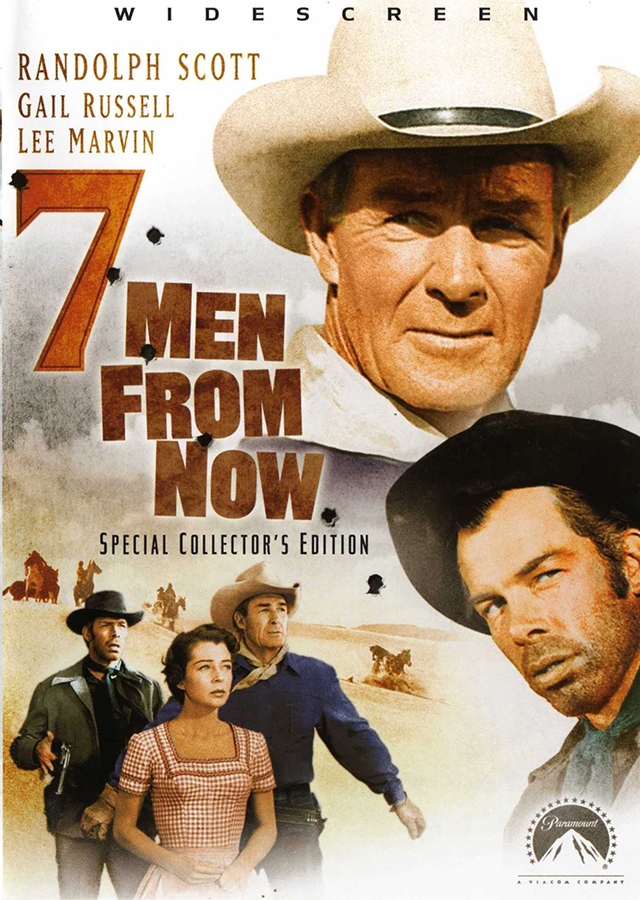
When it was released in 1956 Scott was almost sixty years old. That was the year of Wayne’s greatest film, ‘The Searchers.’ and while the two movies share the conventions of the western there are differences. Let me see if I can put my finger on some of the difference(s).
It starts it the middle at a time when linear story telling was the dominant approach. At the outset Ben Stride (Randolph Scott) seems ominous, and even malevolent. Though the narration soon reveals he is a man on a deadly mission to find and kill the seven men who robbed a Wells Fargo Office during the course of which they shot and killed a clerk, this being Stride’s wife. Thus we have a tale of revenge. Seven to one against Randolph Scott. Don’t take the bet!
He kills the first two within five minutes of run-time. That is fast action. It also seems unjustified. Is not the good guy supposed to try to arrest them and take them back to jail, not provoke a gun fight?
While Scott pursues the villains, in parallel that wonderful heavy Lee Marvin pursues the gold they stole. From the second scene onward, we all know that in the end it will come down to Randolph Scott versus Lee Marvin at even money. Marvin’s villain has a certain vulgar charm and a great deal of intelligence; he is not ravening beast that villains are sometimes made to be. He makes a superb foil for Scott’s reticent decency.
There are some nice twists and turns, personal growth, and irony that is unspoken but revealed in the actors’ faces, all too subtle for the Hollywood hammer these days. Truth to tell, there are also some gigantic plot holes that I will pass in silence. Plot holes remain a common Hollywood currency.
While there are rumours of restive Apaches, these indians are portrayed as victims. The real evil ones are the robbers, and Lee, as he shows soon enough. There is an obligatory old-timer who adds a lighter touch to one scene with some self-deprecating humour. I suppose since Gaby Hayes the old timers are there also to show that a man can grow old in the wild west. The conventions of the western are honoured in this.
There is some marvellous countryside as the wagon (loaded with the illicit gold) rolls to its destiny. It has pastoral moments.
Through it all Scott utters very few words, but when he does, we all know he means exactly what he says, and says exactly what he means — not one word more, not one word less. We all also know he will do what a man has to do in a quiet, dignified way. Wow! What a guy.
By the way, the female lead, Gail Russell, had near-clinical stage fright in front of the camera, and dealt with it by drinking whiskey. She had the reputation of being unreliable and the director Boetticher, the wiki-gossip goes, made a considerable effort to coax her through her scenes and to keep her off the drink during the production. It was her first film in four years and one of her last.
John Wayne made many westerns but he did a variety of other films, while Scott more or less settled in the western genre and stayed there. He accepted and made his own the type casting of the strong, silent loner. Apart from his early career, and the war years, his film credits are westerns, westerns, and westerns, including some based on stories by that stylist of the sage brush, Zane Grey.
By the way, the main difference between ‘Seven Men from Now’ and ‘The Searchers’ is John Ford with his capacity for poetry, faith in the camera to show the grandeur of nature and the small size of men, irony, and even sense of humour. ‘Seven Men from Now’ is just much lower key, nothing mythic about it.
Next up will be ‘The Tall T’ released in 1957.
Category: Film Review
‘That’ll be the day.’
‘The Searchers’ (1956)
After much anticipation I took myself off the Dendy on the Harbour to see ‘The Searchers’ on the wide screen. Wow! I expected that at two+ hours it would drag now and then, but no. The lights went down — and mercifully we were spared Val Morgan’s assault on intelligence — and the titles started. There in the darkened theatre the mythic events and characters came to life. Roger Ebert said a movie is a machine for empathy. Click went the machine.
‘The Iliad’ with the doomed Achilles, ‘The Odyssey’ with the bedevilled Odysseus, and ‘The Searchers’ with the haunted Ethan Edwards are each epics of endurance but also of self-realization. Each is a man of war whose role in peacetime is uncertain, precarious, and unhappy. But each is needed in times of war.
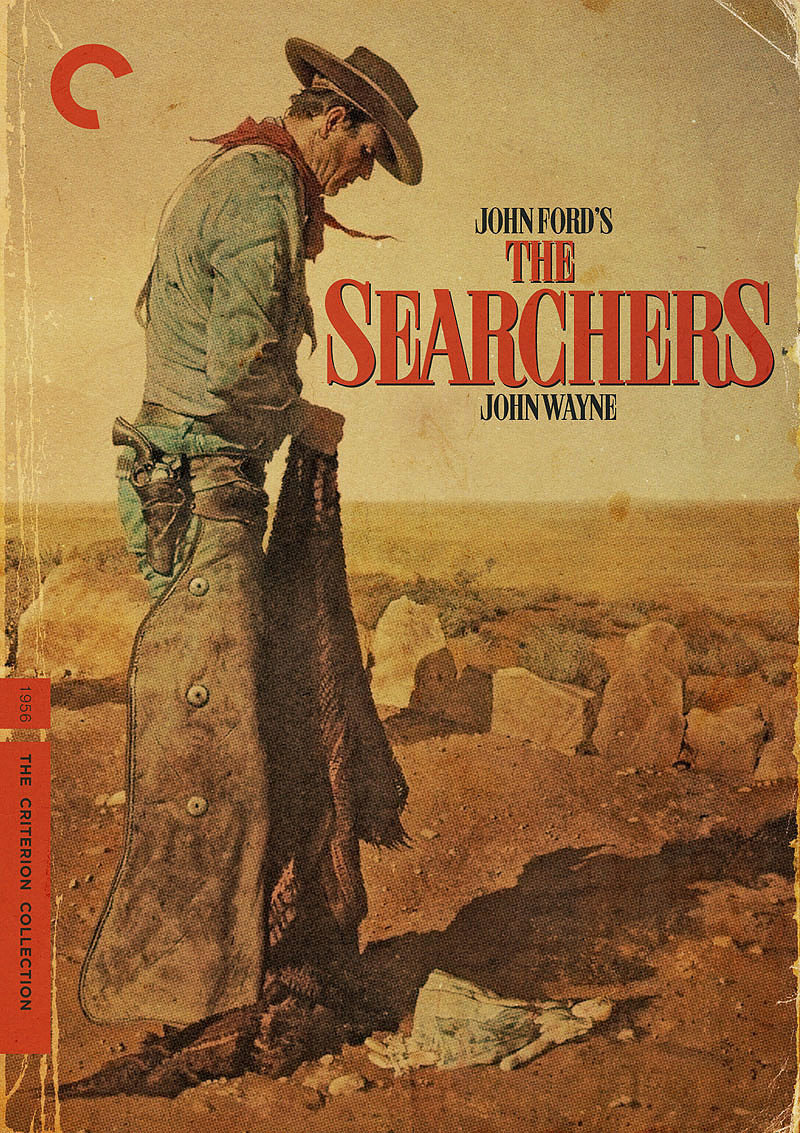
What can be said about ‘The Searchers’ that needs saying, or has not already been said many times? Film schools have dissected its technical aspects, deep focus, Vista Vision, the framing shots, the comic interludes, filming the horseback chases, the terse screenplay, and more that I do not fathom. I am even more sure that Cultural Studies aliens have parsed it into an empty husk in more than one PhD dissertation, burying it under polysyllabic barbarianisms to prove to each other how smart they are. The pygmies must have their days.
Yet it remains on any informed list of great films and at the top of its genre, the Western. ‘Shane’ (1953) is so elegiac it is hard to watch without choking up, and there is no greater moral lesson than ‘High Noon’ (1952) or ‘The Unforgiven‘ (1992), and a personal favourite is the laconic ‘Comes a Horseman’ (1978) or the profound ‘The Misfits’ (1962), not to mention Ford’s own cavalry trilogy. All are excellent and so are many more, ‘Lonesome Dove’ (1989). ‘Ride the High Country’ (1962) but they are second to ‘The Searchers.’ To the reader who has never seen ‘The Searchers,’ what can be said?
First, the film has pace. At nearly two hours, it is long, but the pace keeps an audience engaged, as I rediscovered.
Second, it offers the remarkable landscape of Monument Valley and the Grand Tetons. For the geographically deprived, Monument Valley looks just like its name, a flat, red plain with soaring rock monoliths, while the Grand Tetons are mountains that rise from a high grassy plain without foothills of any kind. (We spent a few days in both some years ago, and they still look just like that.)
 I stood on this very ledge once upon a time.
I stood on this very ledge once upon a time.
Third, there is the cast of characters from John Ford’s stable, each supporting actor getting face time, and some memorable dialogue. Today supporting actors might as well be CGI.
The natural and social context is rich then in place and people.
Four, the Indians are allowed an integrity not seen again in Westerns until Ford’s ‘Cheyenne Autumn’ (1964). The whites fear and hate the Indians for good reason in this world, and vice versa. This is a clash of equals who are enemies.
Fifth, there is the moral tale of redemption as Ethan Edwards, whose hate knows no bounds, whose disappointments are innumerable, whose future is bleak, whose past was bitter hardship and defeat, finds the little remaining humanity he has, much to his own surprise. Some of the close-ups of John Wayne’s expression of hate are works of art.
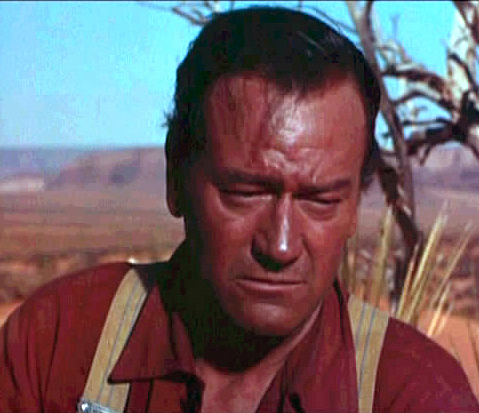
The most powerful one I could not find on the web. That is when he looks back at the crazed women captives at Fort Robinson. It delivers a silent jolt of hatred that foreshadows all that is to come.
This Wayne character is an unpleasant and twisted man, not the anodyne hero he often played. Added to that is the flat voice only he could ever do.
Ethan has one moment of pathos, yet he has no future, ergo the last scene when from the doorway he turns away. This Achilles has no place in an ordered society. He knows that even if no one else does. It is a moment of self-consciousness worth seeing, made the more powerful without either a close-up or a comment. Understatement, thy name is no longer Hollywood.
The story is simple, as epics are. A Comanche raiding party carries away a young girl and the Texicans pursue it. The going is hard, and in time most of the pursuers give up, but not Ethan for whom the pursuit becomes an addiction that gives his miserable life meaning. This man who has lost so much, will not accept another loss. That obsession transmutes into blaming the victim, and when the opportunity comes to rescue the girl, well, there is a moment of profound hesitation and doubt, which is beautifully realised by the camera, the dialogue, the director, the actors, as if for a moment they were all elevated to a higher plane to produce a masterpiece. In this scene, as elsewhere, Director Ford cut lines of dialogue and relied on the actors and camera to tell the tale. All this is silently observed by the vastness of nature broken by a single line of dialogue: ‘Let’s go home.’
The pygmies find much to fault. The cast is replete with the stock characters of westerns. The subplot involving a romance is not well integrated. As there are stock characters, so there are stock events and incidents, a dance, a fist fight, etc. One part of the film is Ethan’s gruelling quest played out against the social context back home. In joining the two, Ford perhaps made the former acceptable to audiences by reassuring them with the latter. Maybe the combination also satisfied him, too. It certainly satisfied Homer because he juxtaposed Ithaca with the war at Troy.
Those who are easily satisfied can hang the label ‘racist’ on Ethan and leave it at that. Ethan does hate, and these Indians have done much to earn his enmity, and vice versa, but Indians are also shown as majestic, insightful, good humoured, and with a nearly divine endurance. The only reprehensible character in the film is the store-keeper Jerem Futterman.
It is a movie that has a coherent screen play complemented with some very astute camera work to punctuate the story, and then there are Ford’s veteran actors who know what to do and how to do it. Though it does lack one of his usual features, namely a chorus to note silently the futility of it all. The assembly of the family on the porch at the initial homecoming is a near example, as are the Comanche women lined up when the Mexican trading party enters. But neither shot is held, nor is there any obvious emotion.
 John Ford on location in Momument Valley
John Ford on location in Momument Valley
That dean of movie reviewers Roger Ebert used words like magnificence, unforgettable, influential to describe it. Though it is clear to this reader Ebert was gun-shy of praising the film too much for fear of eliciting rants from the pygmies. On You Tube there is a comment on the film from Martin Scorsesse who styles Ethan Edwards a ‘poet of hatred.’
Perhaps one day, Hollywood will butcher this one, ah, remake it. How would that go? Scar will be an innocent victim, and will be played by … Angelina Jolie. Like it so far? The Rupert Murdoch’s cavalry will kidnap Scar’s little brother played by Johnny Depp, using his Tonto make-up which hides the white spots on his face. Angelina can lead a band of Amazons to abstract Johnny from the clutches of the villainous general played by … Ron Howard! Is this gold, or what!
Steed is dead. Long live Steed!
That is Major The Honourable John Wickham Gascoyne Beresford Steed, MC, OM, graduate of Eton (where he knew James Bond as the school bully), resident at 5 Westminster Mews. Further details may be found at his Wikipedia entry or in one of the biographies of this estimable but fictional English gentleman.
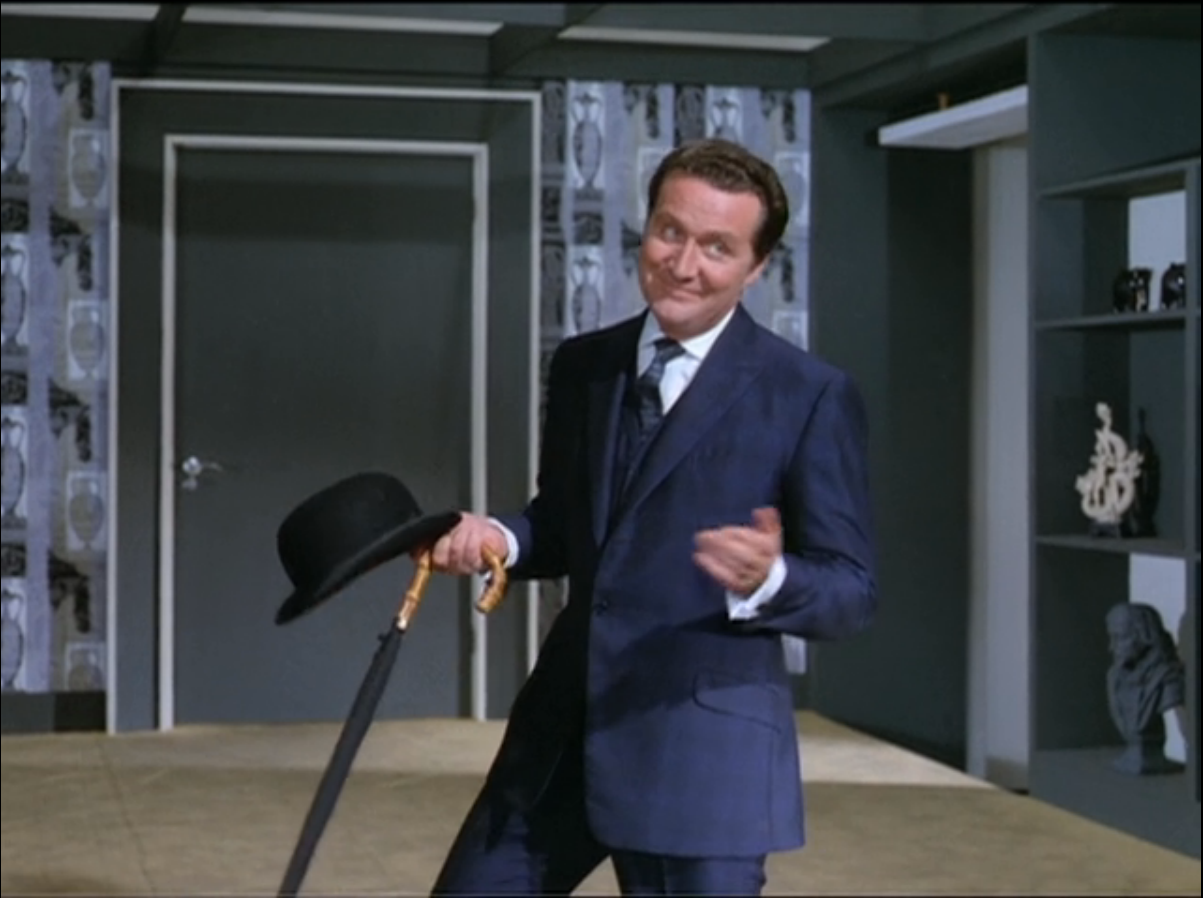 Steed, ready for action with bowler and brolley.
Steed, ready for action with bowler and brolley.
However gallant and distinguished Steed was to earn the MC and OM, he was nothing without Patrick Macnee (1922-2015). Gone recently to his reward.
Steed created the Avengers. The details are many but the nub is this. The original television series was a vehicle for Ian Hendry, called ‘Police Surgeon,’ with Steed as his assistant. When Hendry left to pursue other options, as they say in show biz, the producers gambled on Steed and reshaped the series. Therein lies an explanation for the title, ‘The Avengers,’ for the police surgeon sought vengeance for victims by identifying the villainy and the villain. I know when it was broadcast Stateside a different gloss was put on the title, what I have offered is the historical dimension.
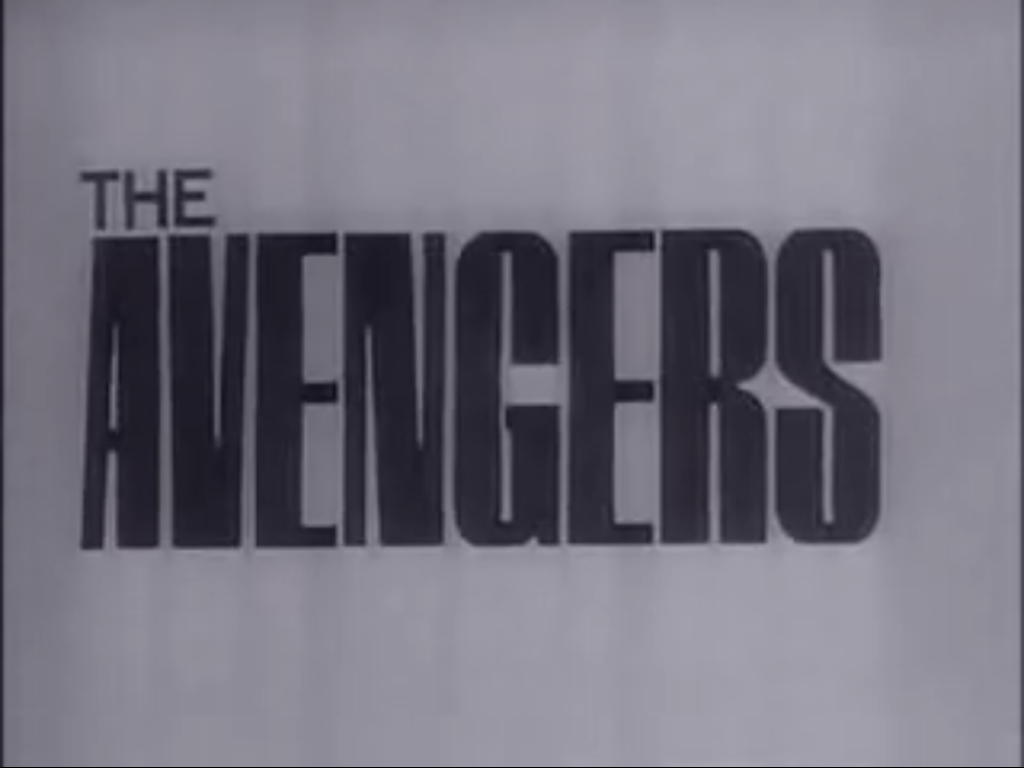
In the 1962-1964 episodes Steed evolved into the bowler hat, the Saville Row suits, the bow tie or ascot, the umbrella, and the ever present smile. In the 1961 series he usually wore a shabby trench coat and a glum expression.
News of Macnee’s death prompted me to spin the old DVDs and watch the 1965-1968 episodes. There are many tribute web sites that say everything that needs to be said and which say quite a bit more than needs to be said. The later evolutions of the series I leave in silence, including even those that retained the services of Macnee.
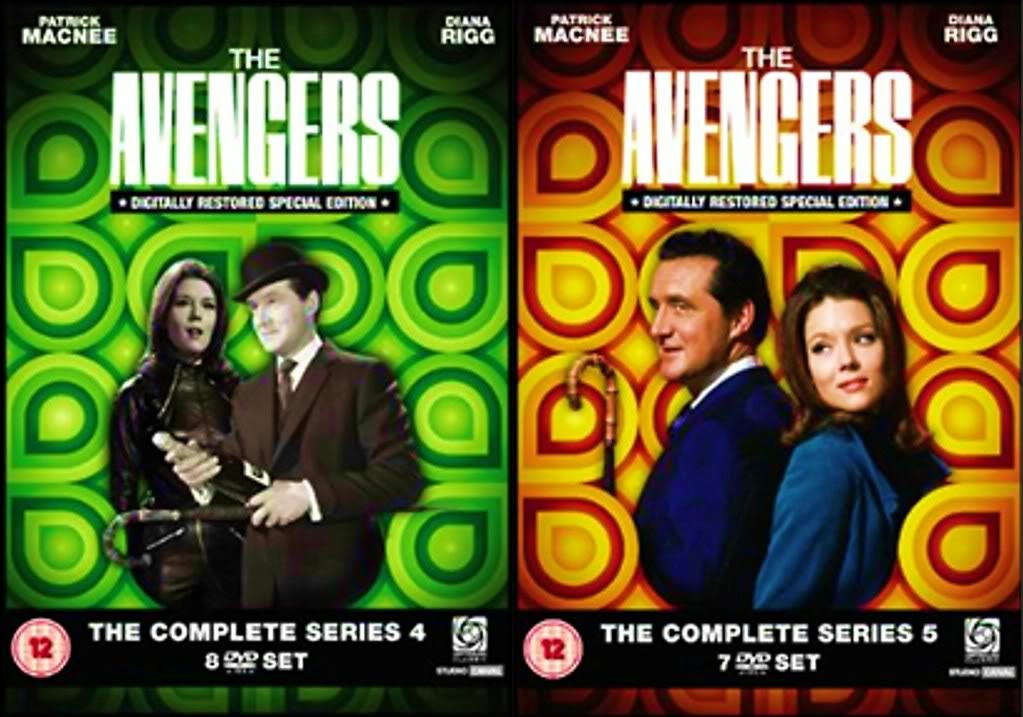
We are at last catching up to the technology of the Avengers:
Pagers
Drones
3 D printing
Mobile telephones
TV remote controls
Self-driving cars
iPods
Web cams
Anti-gravity boots
Electronic IDs
The smart house
Satellite communication
Miniaturisation
But we still do not have Cybernauts.
More generally:
One episode concerned climate change,
another plant genetics
militant feminism
Ebola
student rebellion
Arab oil
Marvel comics
Each ‘ripped from today’s headlines,’ as the movie posters once proclaimed.
On a more personal note I learned from Steed that the glass is always half full, that a smart girlfriend is essential, that tying a bow tie is de rigueur, and a boutonniere is better than a medal. He was also known to drink rosé wine. I have tried to follow his example in all these ways and more.
The award for best victim goes to J. J. Hooter (‘How to Succeed at Murder’) with a close second to Ponsby Ponsby Hopkirk (‘Honey for the Prince’).
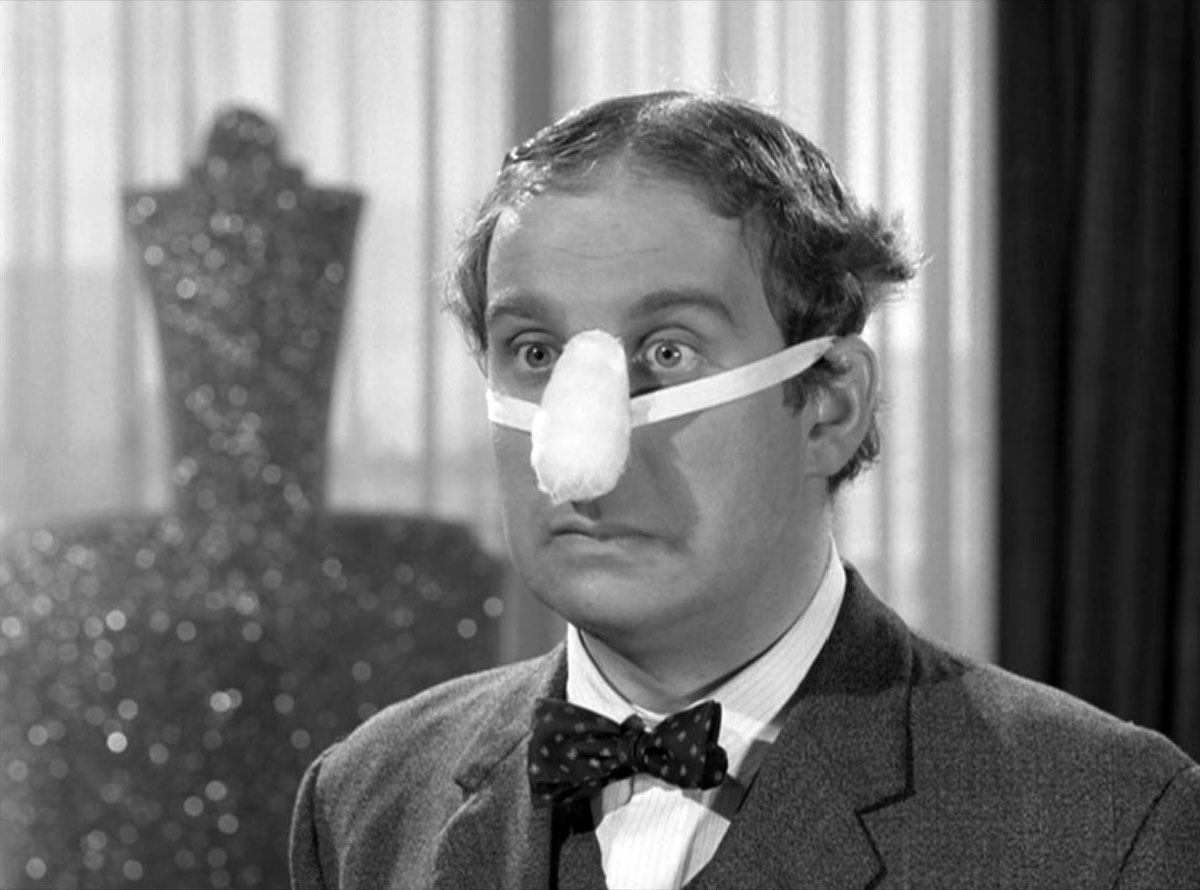 J. J.
J. J.
The unrivalled champion of villainy is Z. Z. von Schnerk (‘Epic’)!
 Z. Z.
Z. Z.
‘The Dog/The Cat’ at the Belvoir Theatre
It is not often that I hear my own department at the University of Sydney mentioned on stage, but it is in this production.

We entered committed to dogs in the eternal world war between the canine and feline, at the end we had to admit that the cat stole the show.
But as any dog will say, the problem with the first part of the title above is that there was NO dog. What is a dog to do if it is not there? That sounds like a Zen question. Moving on.
The staging was exhilarating. The players were exuberant and mournful by turns as we charted the ups and downs of the love lives of the principals.
It is sold out for the remainder of this season but there is a waiting list for cancellations. That might be worth a try.
I booked long ago after reading a review, but when Herself asked me on the night why I had wanted to go I had forgotten the substance of the review. It didn’t matter. The show sold itself. No mediation required.
“Mr Holmes’ (2014)
Dear diary,
We went to see ‘Mr Holmes’ at the Newtown Dendy last night. I am glad we went but I found the film a disappointment. First, the molasses, and then the vinegar.
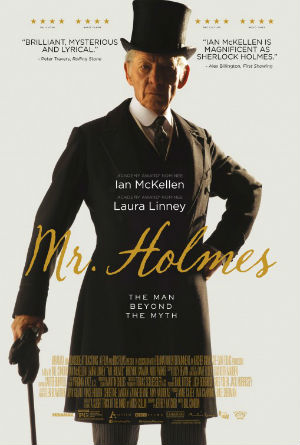
It was a pleasure to watch Ian McKellen hold the camera. Marvellous is this old trouper. And what knees he has for a man born in 1939.
The story does draw from the well of Sherlockiana. Holmes did retire to keep bees on the south coast near Dover. He did have a brother Mycroft whose reach was international. And there were nice touches, e.g., that 221B Baker Street was a false address to mislead curiosity seekers. The glass harmonica pricked my interest and off I went to Wikipedia to be informed. We also cackled at the film within the film, in part because it looked like more fun.
After Hamlet and Henry IV, Holmes must be among the most sought after roles in British drama. Yet having said that there is no Holmes from Laurence Olivier and the other celluloid knights. McKellen certainly lives up to the standard. It was because of him we went, as it was because of Robert Downey that we did not go see his 2009 travesty,
McKellen at 77 convincingly handles the various flashbacks and forwards from 93 to 58. Though what the point of the flashbacks and forwards was, that was lost on us. It just seemed pointless to put Holmes in Hiroshima. The film is based on the novel ‘A Slight Trick of the Mind’ (2006) by Mitch Cullen for those who want to make up their own minds. Perhaps it makes more sense there.
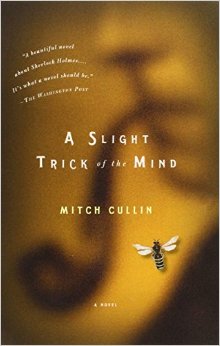
The supporting players were fine, though it was all so predictable. Mrs Munro was just cardboard. Full marks for transforming American beauty Laura Lynney into this Devonshire frump. Roger goes from monosyllabic to articulate in one scene. Me thinks also, the author of the screen play has not spent much time with the elderly. It is not just not remembering but not knowing that one is not remembering. When it is gone; it is all gone. One does not struggle to remember, rather it is gone without a trace.
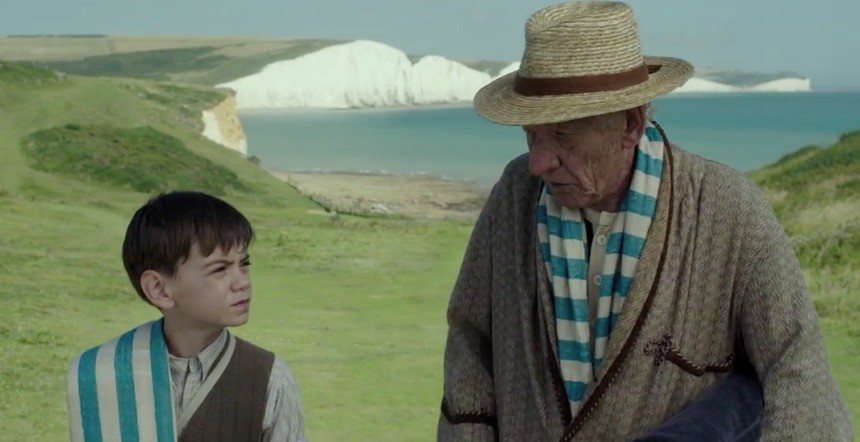
The mystery of beehive murders, now that would certainly have been enough plot for a good film, about Holmes passing the baton — the deerstalker — to Roger, but that was nearly lost in the all the flashes this way and that until it was needed to find somewhere to end.
The setting along the white cliffs was nice but throughout the cinematography was washed out and blurred.
‘Departures’ (2008)
Thanks to the miracle of SBS Television we went to Japan last night and got back in time to go to bed, watching ‘Departures,’ a life-affirming film with cello music about death. Slow, meticulous, and accessible with some travelogue, the story of young Daigo Kobayashi’s transition from mediocre cello player to encoffiner is related, and the effects of the move on those around him, starting with his loyal, but taxed wife.
‘Encoffiner’ is one word Noah Webster did not get. In this case it means laying out of dead person to be placed into a coffin. This is a task performed before the undertaker disposes of the body. ‘Task,’ no, not the right word. Ritual is the word, a performance before the deceased’s family. It is done with the decorum, grace, and precision of the best of Japanese culture, but achieving that takes time and practice, and sometimes the difficulty is compounded by the emotions which the death has unleashed in the family. All of this, and more, is carefully documented as Daigo, reluctantly, enters this world.
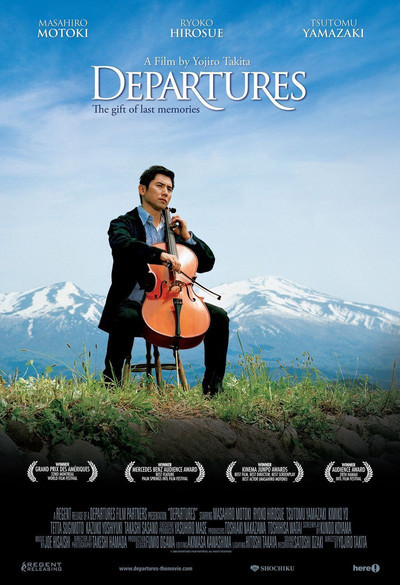
He is broke, in debt far beyond Mika’s, his wife, wildest guess: celli are expensive. The ready money NK Agents offers is too tempting to refuse.
His initial revulsion at both the physical and social aspect of the work is gradually overcome when he realises slowly that the ceremony is of great solace to many families. In time he finds solace of his own in the task. Though it does take a longtime to close the loops and there is more repetition than I liked. Robert Ebert reviewed it in 2009 and gave it four stars out of four and wrote his usual perceptive comments with some comparisons to other films.
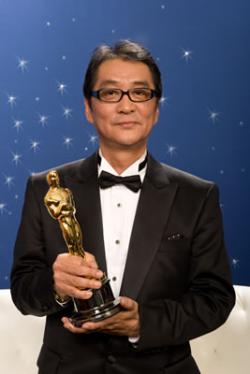 Yojiro Takita, the director with the Oscar for best Foreign Picture.
Yojiro Takita, the director with the Oscar for best Foreign Picture.
We could have watched Computer Generated Images slug it out on 7MATE but we preferred something about life and people, not comic strip nonsense made by prepubescent boys for prepubescent boys, or is that the other way around. Or we could have been hectored by an ABC journalist firmly brandishing one end, usually the wrong end, of a stick. So many choices.
I record a selection of SBS free-to-air movies based on David Stratton’s comments in ‘TV Week.’ I use his comments and not his ratings, which I find too high, though he has recently changed the method and I am still trying to gauge his new approach of categorising rather than numbering.
‘Mittsommernachtstango’ (2013)
This is a feature film from Finland, the land of low-key but often very interesting and accessible movies.
Genre? Mockumentary, I guess. It is told deadpan. A Finn writes to a tango club in Buenos Aires, claiming that the tango originated in Finland, and supplies a long and detailed history of its evolution in the far north of the far north. While the Argentines laugh it off, it is, well, curious, and what, after all, is Finland like that these people would make such a stupid claim.
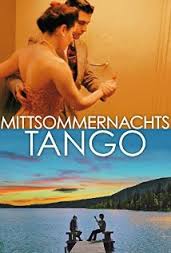
Three of them club together — a guitar player, a singer, and a dancer — to head north to the land of midnight sun, endless forests that all look alike, wrong turns, language barriers, a dead battery, and reindeer on the road.
They find something they never found in Buenos Aires, peace-and-quiet, and also people who have plenty of time for them to get past that language barrier and they learn some things about themselves, Finland, and even the tango, as they finally admit. The explanation of why Finnish men like the tango is perfect.
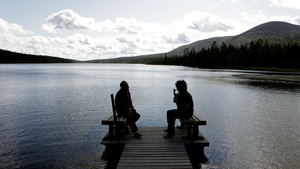

Completely unpretentious, no plot twists, plenty of travelogue, first in Buenos Aires and then Lapland. That deity of film criticism Roger Ebert would certainly give it all thumbs up, and so do I.
Fiction? Well not quite. See Wikipedia for an entry on the Finnish tango, and be enlightened.
I read a charming review of this Finnish film about a year ago, and determined to have a look at it. I tried to get it on iTunes but failed. It could not be sold into the Australian market. I even tried to fool iTunes by logging in while in the States to no avail. Though it was available for purchase, I could not purchase it. Frustrating. Yet another chance to develop my patience. (Yes, I know about VPN, but my needs are few.)
I thought that by June 2015 it would surely be available. I was assuming it would be screened at the Sydney Film Festival, since it seemed perfect for that, and then have a commercial release and we could see it on the wide screen. I checked with a Film Festivalian of my acquaintance, who said no, it was not on the program. Rats!
I tried again to locate it for purchase and lo and behold I found a vendor and ordered it toute suite! It promptly arrived and we gave it a spin.
‘Detective Dee and the Mystery of the Phantom Flame’ (2010)
Robert van Gulik (1910-1967), a Dutchman, wrote a series of krimies featuring Dee. Gulik was an orientalist and lived most of his life in the Far East. Scrupulously following the trail of historical authenticity in the novels, Gulik’s Dee is a judge, rather like a circuit court judge who travels around China finding wrongs and righting them, and not a detective. One supposes that the label ‘detective’ is used to make Dee accessible to contemporary audiences, unlikely to know their own history. Having read a couple over the years, when I saw this title in the SBS line up, I was curious to see what contemporary Chinese would make of a European’s appropriation of their society fifty years ago.
 Robert van Gulik
Robert van Gulik
The short answer is not much. This is an original story, per the IMDB information, and the title does not match any of Gulik’s at my glance. I rather think this film takes more liberties with Chinese historical accuracy than did Gulik. It seems as free as a Hollywood script, veering this way and that, with talking animals, ghosts, and other excuses for CGI, CGI, and more CGI, without a meaningful story line or characters with any depth. A moving comic book, but then Stan Lee has ascended to royalty on that. I let it run but assigned only 1% cognitive attention to it while plowing through the NYT Sunday crossword puzzle.
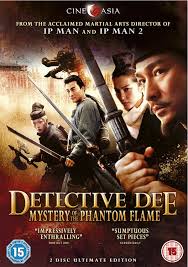
IMDB scores is 6.6 and some reviewers found it ‘enthralling’ and ‘sumptuous.’ I found it repetitive, predictable, incomprehensible, and boring by turns. Something for everyone then.
There are ghosts in the Dee stories I know, but inevitably it turns out that some villain is trading on the belief in ghosts to get up to some dastardly deed, and the no-nonsense Judge Dee soon settles that!
‘Casablanca’ (1942)
Reading about Vichy France reminded me of this film, so I watched it again.
Love the film, but not the many historical inaccuracies in it, though it is easy to forgive them, still we should not forget them. Here are a few.
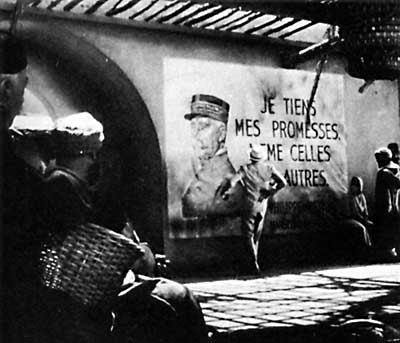
1.There were Germans in Morocco to monitor the neutrality of the Vichy Administration, but none were permitted to wear uniforms.
2.The Germans dressed in mufti and were confined to poor hotels in Rabat, not Casablanca.
3.The Germans were permitted out and about only when escorted by many French soldiers, almost as though they were prisoners. Had they travelled to Casablanca, they would have had a large French military escort.
4.The French governor of Morocco in Rabat, General Auguste Noguès, had in 1940 advocated continuing the war from North Africa, and he made as many difficulties as possible for the Germans in Morocco, while following the letter of his orders to cooperate. There were complaints by the Germans, but the matter was too low a priority for pressure to be exerted.
5.Ergo there would have been no singing in nightclubs.
6.No questioning of travellers.
7.No truckloads of German soldiers.
8.That immutable letter of transit is wrong, too. De Gaulle’s signature would have landed the bearer in the slammer. Pėtain’s signature perhaps.
9.There was little if any unity among the anti-Nazis within a single country let alone internationally as depicted in the film. No Norwegian would not flash the cross of Lorraine to anyone let alone a Czech.
10. There was a sizeable language barrier between Norwegians, Bulgarians, Czechs, French.
The deep ambiguity of the situation is certainly true and Casablanca was perhaps, I do not know, a magnet for refuges.
Hitler’s only interest in the French Empire was to keep it and its colonial army, warships at anchor, and other military, financial, and natural resources from the Allies. Germany did not have the troops or the access to the four corners of the globe directly to do this, but if the paper-mâché regime at Vichy could effect those exclusions, it was worth the comic opera pretence that it was independent.
There is another ambiguity, too, that of the Roosevelt’s enduring effort to maintain diplomatic relations with Vichy, first when both it and the USA were neutral, and when the USA entered the war he tried hard to maintain diplomatic relations with the still neutral Vichy. Ergo there may well have been an American consul in Casablanca.
FDR also undermined de Gaulle for years, even after the invasion of North Africa, when much to the chagrin of some advisors to FDR, the French troops there responded to de Gaulle, and not the puppet they had put up instead.
These ambiguities muddle the clean lines of the story from the first shooting in front of the poster of Pėtain’s to the bottle of Vichy water at the end, but they explain how confused and confusing the situation was for those individuals.
It is unlikely that the screenwriters had this detailed knowledge. And finally, who cares! It is entertainment not a history lesson.
Mørke (2005)
A Danish drama courtesy of SBS. The title translates as Murk.
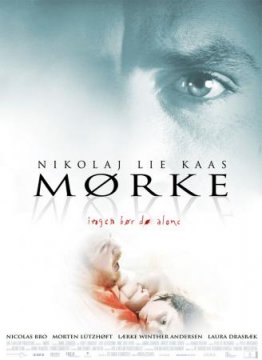
It is a study in ambiguity and the viewer’s sympathies flow back and forth between Jacob and Anker. Is Jacob, the tall dark, handsome, and assured Copenhagen journalist, an obsessive nut case, while the fat, ugly, placid farmer Anker the victim of circumstances? Or is Anker a devious serial murderer several steps ahead of Jacob, who was right about him all along? Most of the action occurs in the village of Murk (indeed) in Jutland, flat, wet, brooding skies, the smell of farms (manure)…. Be glad there is no Smell-O-Vision. [Remember that? Just wait; it will come again.]

The local plod cannot believe Jacob’s wild accusations, and he certainly is unstable by then. But Anker is on a mission and he cannot deviate….
With the resolution at the end, a number of loose ends arise: Did Hanne make the last phone call? Where is the razor blade or knife?
Maybe we need a little more of Anker to understand the mission. Is it because he, too, is outcast by his looks and so knows what his victims really want even if they never say it, may not ever say it. Why did Jacob keep waking up to answer the phone that did not ring?

In Denmark, one of the most regulated societies, could a serial widower like Anker pass unnoticed by the police, media, and the vigilantes of the blogosphere? Still less in the small villages where he passed. But what if he could….
